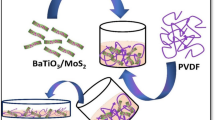Abstract
Molybdenum disulfide (MoS2) material is mainly used in various electronic applications and in the solar energy harvesting process. In this work, MoS2 nanoparticles are used for piezoelectric vibration energy harvesting applications. MoS2 nanoparticles are synthesized by a hydrothermal process. The synthesized nano-MoS2 is inserted into polyvinylidene fluoride-trifluoroethylene P(VDF-TrFE) to form the MoS2/P(VDF-TrFE) nanocomposite. Through the presence of nano-MoS2 particles in the polymer chain and elemental molecular binding energy, phase transformation is confirmed by scanning electron microscopy (SEM) with energy dispersive spectrometer (EDS), x-ray photoelectron spectroscopy (XPS) and Fourier transform-infrared spectroscopy (FTIR), respectively. MoS2 nanoparticles in a polymer composite enhance the dielectric behaviour three times higher than that of the pure P(VDF-TrFE) as measured by an impedance analyzer. The four types of energy harvesting devices are fabricated based on the substrate effect like P(VDF-TrFE) without substrate, P(VDF-TrFE) with PET substrate, MoS2/P(VDF-TrFE) without substrate and MoS2/P(VDF-TrFE) with PET substrate and this devices natural resonance frequency, output voltage performance are analyzed by using LDV and shaker. MoS2/P(VDFTrFE) with PET substrate piezoelectric cantilever harvests more AC output voltage 2.96 V in the size of 1 cm * 0.5 cm length and width, respectively.












Similar content being viewed by others
References
S. Priya, and D. Inman, Energy harvesting technologies, 2nd ed. (New York: Springer, 2008).
A. Eruturk, and D.J. Inmam, Piezo electric energy harvesting (Hoboken: Wiley, 2011).
J.S. Harrison and Z. Ounaies, Piezoelectric polymers. In: ICASE, National Aeronautics and Space Administration (Langley Research Center Hampton, Virginia, 2001), pp 1–32. https://ntrs.nasa.gov/api/citations/20020044745/downloads/20020044745.pdf
C. Baur, D.J. Apo and S. Priya, Advances in piezoelectric polymer composites for vibrational energy harvesting. In: Polymer Composites for Energy Harvesting, Conversion, and Storage, ACS Symposium Series, Chaper 1 (American Chemical Society, Washington, DC, 2014), pp. 1–27. https://doi.org/10.1021/bk-2014-1161
B. Gnade and M. Quevedo-Lopez, Ferroelectric properties and polarization switching kinetic of poly (vinylidene fluoride-trifluoroethylene) copolymer, ferroelectrics—physical effects, (2011), book Chapter 4, pp 77–99, ISBN:978-953-307-453-5. https://doi.org/10.5772/17147.
T. Kajihara, Y. Ueno, and Y. Tsujiura, Jpn. J. Appl. Phys. 56, 4S (2017). https://doi.org/10.7567/JJAP.56.04CL04.
D.M. Marquis, É. Guillaume, and C. Chivas-Joly, Properties of nanofillers in polymer. In: Nanocomposite and Polymer with Analytical Methods, Chapter 11 (John Cuppoletti, Intech Open, 2011). pp 262–284. https://doi.org/10.5772/21694.
D. Singh, A. Choudhary, and A. Garg, ACS Appl. Mater. Interfaces. 10, 3 (2018). https://doi.org/10.1021/acsami.7b16973.
H. Zhu, Y. Wang, and J. Xiao, Nat Nanotechnol 10, 151 (2015). https://doi.org/10.1038/nnano.2014.309.
N.J. Dimple and S.D. Behere, J. Phys. Chem. C 121, 17 (2017). https://doi.org/10.1021/acs.jpcc.7b01970.
J. Sun, X. Li, and W. Guo, Curr. Comput. Aided Drug Des. 7, 198 (2017). https://doi.org/10.3390/cryst7070198.
X. Yumei Tian, L.S. Zhao, F. Meng, and L. Tang, Mater. Lett. 60, 4 (2006). https://doi.org/10.1016/j.matlet.2005.09.029.
W. Zhang, P. Zhang, and S. Zhiqiang, Nanoscale 44, 7 (2015). https://doi.org/10.1039/C5NR06121K.
A. Steinhoff, M. Rosner, and F. Jahnke, Nano Lett. 14, 7 (2014). https://doi.org/10.1021/nl500595u.
W. Wu, L. Wang, Y. Li, and F. Zhang, Nature 514, 470 (2014). https://doi.org/10.1038/nature13792.
X.-W. Zhang, D. Xie, Xu. Jian-Long, Y.-L. Sun, and X. Li, IEEE Electron Device Lett. 36, 8 (2015). https://doi.org/10.1109/LED.2015.2440249.
X. Li and H. Zhu, J. Materiomics 1, 1 (2015). https://doi.org/10.1016/j.jmat.2015.03.003.
T. Wua, Y. Songa, and Z. Shia, Nano Energy 80, 105541 (2021). https://doi.org/10.1016/j.nanoen.2020.105541.
D. Zhanga, Z. Yanga, and P. Lib, Nano Energy 65, 103974 (2019). https://doi.org/10.1016/j.nanoen.2019.103974.
Wu. Chaoxing, ACS Nano 11, 8 (2017). https://doi.org/10.1021/acsnano.7b03657.
C. Jiang, Q. Li, and J. Huang, ACS Appl. Mater. Interfaces 12, 37 (2020). https://doi.org/10.1021/acsami.0c11913.
A. Almusallam and Z. Luo, Nano Energy 33, 146 (2017). https://doi.org/10.1016/j.nanoen.2017.01.037.
S.V. Prabhakar Vattikuti and C. Byon, J. Nano Mater. 201, 710462 (2015). https://doi.org/10.1155/2015/710462.
G. Tang, J. Sun, and C. Wei, Mater. Lett. 86, 1 (2012). https://doi.org/10.1016/j.matlet.2012.07.014.
Y.-H. Lee, X.-Q. Zhang, and W. Zhang, Adv. Mater. 24, 17 (2012). https://doi.org/10.1002/adma.201104798.
J. Iranmahboob, D.O. Hill, and H. Toghiani, Appl. Surfaces Sci. 185, 72 (2001). https://doi.org/10.1016/S0169-4332(01)00653-5.
L. Luo, M. Shi, and S. Zhao, J. Saudi Chem. Soc. 23, 6 (2019). https://doi.org/10.1016/j.jscs.2019.01.005.
P. Dwivedi, S. Das, and S. Dhanekar, ACS Appl. Mater. Interfaces 9, 24 (2017). https://doi.org/10.1021/acsami.7b05468.
L. Zhao, J. Jia, Z. Yang, and J. Yu, Appl. Catal. B Environ. 210, 290 (2017). https://doi.org/10.1016/j.apcatb.2017.04.003.
S. Kim, I. Towfeeq, and Y. Dong, Appl. Sci. 8, 213 (2018). https://doi.org/10.3390/app8020213.
J. Han, D. Li, and C. Zhao, Sensors 19, 830 (2019). https://doi.org/10.3390/s19040830.
N. Maity, J. Mater. Chem. C 5, 46 (2017). https://doi.org/10.1039/C7TC03593D.
J. Arunguvai and P. Lakshmi, J. Mater. Sci. Mater. Electron. 31, 8283 (2020). https://doi.org/10.1007/s10854-020-03363-1.
J.-H. Lee, Adv. Mater. 26, 5 (2014). https://doi.org/10.1007/s10854-020-03363-1.
S.A. Han, T.-H. Kim, and S.K. Kim, Adv. Mater. 30, 21 (2018). https://doi.org/10.1002/adma.201800342.
S.K. Kim, R. Bhatia, and T.-H. Kim, Nano Energy 22, 483 (2016). https://doi.org/10.1016/j.nanoen.2016.02.046.
Acknowledgments
All the material characterization measurements reported in this work were carried out in the Centre for Nano Science and Engineering, Indian Institute of Science, Bangalore, India.
Author information
Authors and Affiliations
Corresponding author
Ethics declarations
Conflict of interest
The authors declare that they have no conflict of interest.
Additional information
Publisher's Note
Springer Nature remains neutral with regard to jurisdictional claims in published maps and institutional affiliations.
Rights and permissions
About this article
Cite this article
Arunguvai, J., Lakshmi, P. Flexible Piezoelectric MoS2/P(VDF-TrFE) Nanocomposite Film for Vibration Energy Harvesting. J. Electron. Mater. 50, 6870–6880 (2021). https://doi.org/10.1007/s11664-021-09204-z
Received:
Accepted:
Published:
Issue Date:
DOI: https://doi.org/10.1007/s11664-021-09204-z




